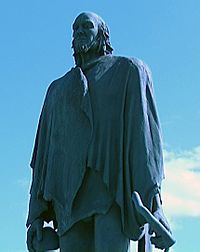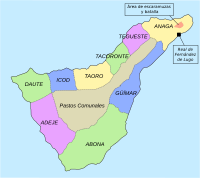Battle of Aguere facts for kids
Quick facts for kids Battle of Aguere |
|||||||
|---|---|---|---|---|---|---|---|
| Part of Castilian conquest of Tenerife | |||||||
|
|||||||
| Belligerents | |||||||
| Guanches | |||||||
| Commanders and leaders | |||||||
| Alonso Fernández de Lugo | Bencomo Acaymo Tinguaro Beneharo |
||||||
| Strength | |||||||
| 1,200 infantry, 70 knights, 600 Guanche allies | 6,000–11,000 | ||||||
| Casualties and losses | |||||||
| 30–60 dead, many dozens injured | 2,000 dead | ||||||
The Battle of Aguere, also known as the Battle of San Cristóbal de La Laguna, was a big fight in Tenerife. It happened on November 14-15, 1494. This battle was between the forces of the Crown of Castile (from Spain) and the native people of Tenerife, called the Guanches.
The Castilian army was led by Alonso Fernández de Lugo, a military governor. He had lost a battle against the Guanches before, called the First Battle of Acentejo. But the Battle of Aguere was different. The Castilians won this time. In the first battle, the Guanches knew the mountains well, which helped them. However, in this battle, they fought on a flat plain called Aguere, which put them at a disadvantage.
The Battle of Aguere was followed by another important fight, the Second Battle of Acentejo. This final battle led to the complete takeover of Tenerife by the Castilians.
Contents
Preparing for Battle
After losing the First Battle of Acentejo, Alonso Fernández de Lugo went back to Gran Canaria. He had very few soldiers left. Many Castilian soldiers had died or were hurt in the first battle.
In Gran Canaria, Fernández de Lugo looked for money to help him conquer Tenerife. He got help from rich merchants and even from a powerful noble, Juan Alfonso Pérez de Guzmán, the Duke of Medina Sidonia. The Duke sent 600 soldiers and 30 horsemen who were experienced fighters.
Fernández de Lugo also got 500 more Castilian soldiers. This group included some who had survived the first battle. Even the King and Queen of Spain, Ferdinand and Isabella, gave him more time to finish his conquest.
On November 6, the Castilian army sailed from Gran Canaria. They had about 1,200 men, including a small group of knights and some artillery (cannons). This army was similar in size to the one that lost before, but they were much better trained and ready.
The Castilian Advance

Lugo had used all his own money to fund this trip. His army landed at Santa Cruz, where they built two towers. These towers were in the same place where he had built a fort before his earlier defeat.
After making Santa Cruz safe, the Castilians marched on November 13-14. They headed towards La Cuesta, a high, important spot. From there, they could reach San Cristóbal de La Laguna from the coast.
Santa Cruz was their main base. Their ships waited there in case they needed to retreat. The flat area of San Cristóbal de La Laguna was very important for taking over the island. The path to get there, La Cuesta, was covered in thick trees and plants. This made climbing up the hill very dangerous.
Fernández de Lugo left soldiers in Santa Cruz to prevent surprise attacks. Meanwhile, the Guanches, warned by people on the coast, gathered their fighters. The Guanche king, or mencey, Bencomo, sent messages to other kings. He gathered about 2,000 warriors at La Cuesta before the Castilians arrived.
Bencomo sent two spies to check on the Castilian army's strength. But the Castilians caught the spies. This meant Bencomo didn't get any information about his enemy. This gave the Castilians an early advantage. Even though they were climbing a difficult hill, they were ready.
Fernández de Lugo saw the Guanche campfires. He ordered his 70 horsemen and 1,000 soldiers to climb La Cuesta in the dark. They reached the highest point of La Cuesta without being seen.
The Battle Begins
The next day, the Guanche forces were surprised. The Castilians had climbed La Cuesta and were now on the high ground in the middle of the Aguere plain. This area, called Aguere by the natives, was covered in laurel forests.
Bencomo quickly got his forces ready. With 5,000 men, he rushed towards what is now the edge of San Cristóbal. He wanted to stop the Castilians. But Fernández de Lugo's army was already there.
Bencomo led the middle of the Guanche army. Acaymo, the king of Tacoronte, led the right side. Tinguaro led the left side.
The Castilian army stretched from a high point chosen by Fernández de Lugo, to where Bencomo's troops were. This suggests the battle happened in areas now known as Barrio del Timple, Barrio Nuevo, or Urbanización de la Verdellada.
Fernández de Lugo's army also included natives from other Canary Islands. These were Christianized Guanches, like Prince Fernando Guanarteme from Gran Canaria. His brother Maninidra was also there, along with people from La Gomera, La Palma, and Guanches from the Christianized kingdom of Güímar.
The battle started with an attack by the Guanche troops. They used traditional weapons like the banote, a spear with a fire-hardened tip. They had no shields or armor. They wore tamarco, a sheep or goat skin for protection and warmth. The Guanches also threw rocks.
The Castilian front line had soldiers with harquebusiers (early guns) and crossbowmen. They fired their weapons, hitting the attacking Guanche soldiers. Then, Castilian soldiers with long spears (pikemen) and horsemen attacked the Guanches who were running from the gunfire. This first part of the battle lasted several hours. Bencomo's forces kept attacking head-on.
The flat land of Aguere helped the Castilians. Bencomo's troops began to struggle and retreat in a messy way. This got worse when the Guanche allies of the Castilians, led by Fernando de Guanarteme, arrived from Santa Cruz. The Castilian cavalry (soldiers on horseback) caused huge losses for the Guanche forces.
Guanche Retreat and Tinguaro's Death
Bencomo, Acaymo, and Tinguaro were all badly hurt. They told their forces to retreat towards Tacoronte. The Castilians attacked again, making it hard for the Guanches to retreat in an orderly way. Bencomo ordered a retreat towards the peak of San Roque. This high ground would protect his men from cavalry attacks.
Tinguaro, injured in the battle, kept fighting against seven horsemen as he retreated up San Roque. But a Castilian soldier named Martín Buendía was waiting for him on a cliff. Buendía had come to the battle separately.
Tinguaro, badly hurt and losing blood, spoke to Buendía in the Guanche language. He told the Castilian that he was a prince. But Buendía didn't listen. He killed Tinguaro with a spear.
However, some historians have a different story. They say that Bencomo, not Tinguaro, was killed by Buendía on November 14, 1494. They say Bencomo fought against ten Castilian soldiers on the slopes of San Roque. Tinguaro was also hurt but died two days later.
In a final effort, the remaining Guanche forces, led by an injured Bencomo, tried to reach the heights of La Laguna. But the Castilian cavalry cut them down. The cavalry was followed by Castilian pikemen and "shield bearers" (rodeleros) with steel shields and swords. One of these rodeleros killed Bencomo. Hundreds of Guanche warriors also died. The Guanche survivors went towards Taoro. The next day, they chose Bencomo's son, Bentor, as their new king.
Some historians question if Bencomo died at this exact moment. But most agree he did, based on what witnesses said. For example, Margarita Guanarteme said in 1526 that in the battle, "they killed the Great King who was called King Venitomo [Bencomo] of Taoro..."
Many Guanches died in the battle. Some say 2,600, while others say 1,700. The Castilians had fewer losses, with about 30 to 55 dead and many injured. The high number of Guanche deaths might have even caused a sickness to spread, which made Fernández de Lugo move his army towards Acentejo.
After the Battle
By the end of the year, Fernández de Lugo would go into the north of the island, to Taoro. About 6,000 Guanches were waiting for him there at Acentejo. Fernández de Lugo would win a very important victory against these forces in the Second Battle of Acentejo.
See also
 In Spanish: Batalla de La Laguna para niños
In Spanish: Batalla de La Laguna para niños


